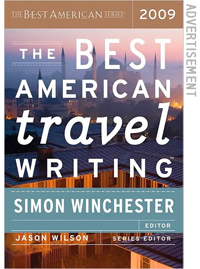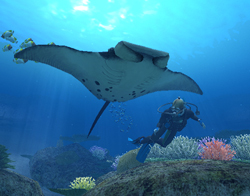“Go to a place, report on its culture, foibles, distractions, and bring it back to entertain your readers…it’s not enough just to say what happened — you have to make people understand what it felt like to be there when it happened.” This seems like a pretty good description of travel writing, right? It wouldn’t seem out of place as advice given by an editor to a first-time travel writer. But actually, this quote is by a video game journalist named Kieron Gillen, taken from a manifesto he wrote not too long ago on what he calls “The New Games Journalism” (after Tom Wolfe’s famous term “The New Journalism”). In his manifesto, Gillen exhorts his video game colleagues to become “Travel Journalists to Imaginary Places.”
“The thing with travel journalism or reportage is that it’s interesting even if you have absolutely no inclination of going there,” he writes. A key difference between travel writing and video game writing, according to Gillen: “Our job is to describe what it’s like to visit a place that doesn’t exist outside of the gamer’s head…The worth of gaming lies in the gamer not the game.”
I was recently struck by how similar this is to Paul Theroux’s memorable assertion about travel writing: “The misperception is that the travel book is about a country. It’s really about the person who’s traveling.”
An old girlfriend also once insisted that travel writing was a lot like playing video games — though it was not a compliment. This girlfriend fancied herself an intellectual and a literary person and looked down on travel writing as well as video games, and her comment was an attempt to dissuade me from both activities, which she believed were keeping me from finishing the Great American Novel. This was probably true, but it didn’t bode well for our long-term prospects. We were in a dive college bar in Boston when she sternly pointed a French fry at me and said, “You know, I read an essay recently by these scholars from MIT. And they put forth this thesis that the simplistic narratives of many video games have their parallels in travel writing narratives.”
This was around 15 years ago, when it was not uncommon to find myself in a certain type of ridiculous-but-supposedly-deep conversation, debates about whether or not the Smurfs were actually Communists or whether Ho Chi Minh had once worked as a pastry chef for Escoffier or whether Mikey from the Life cereal ads had truly died from mixing Pop Rocks and soda. During that period, for instance, I once used the plot of Scooby Doo to teach a freshman writing class about narrative.
Nintendo’s Street Fighter II was the video game she used as an example. “You know how in Street Fighter, the two characters fight in all these different exotic global spaces? In one fight, they’re in a Chinese street market. Then they’re in a Japanese temple. Then they’re on a dock in the Amazon. Then they’re in a Soviet-style factory. Then they’re in a Vegas casino. In some scenes, they have flamenco dancers behind them. In others, they have Indian men riding elephants. Anyway, the scholars’ point was this: All of the worlds that the fighters enter are really just eye candy, simply ornamental local color. All these new places are consumed by the game player one after another, and the video game makers understand that they need to keep changing the scenes, with all new local color, or else the game will become boring. But while all the eye candy always changes, the same basic plot and the same basic narration — in this case, two street fighters kicking the crap out of one another — never changes.”
“I see,” I said, with a raised eyebrow.
“Well,” she said, growing more argumentative, “don’t you agree that travel writing, or even just the travel stories most people tell, present a similar worldview? That people basically play out their same personal dramas no matter where they go. That only the eye candy changes.”
“Um, no,” I said. “Actually, that sort of sounds insane.” This led quickly into one of the stupider arguments in a long line of very stupid arguments.
Not too long after we’d broken up, I came across the essay she’d referenced, “Nintendo and the New World Travel Writing: A Dialogue,” by Mary Fuller and Henry Jenkins. Fuller and Jenkins likened Nintendo’s Mario Brothers’ adventures in rescuing Princess Toadstool to the nonfictional New World travel narratives of John Smith, Virginia Dare, and Pocahontas in the lost colony of Roanoke. Both are “forms of narrative that privilege space over characterization or plot development” and “a different way of organizing narratives” that they call “spatial stories.” At the time, it seemed like the sort of loopy scholarship that got debated over a bong in someone’s dorm room. But now I’m not so sure.
I thought seriously about travel writing and video games this past year when reading hundreds of nominations for The Best American Travel Writing. I spent a lot of that period playing Wii with my two sons. We enjoyed a game called Endless Ocean, in which you play the role of a deep-sea diver who, along with a somewhat irritating companion, a marine biologist named Katherine, explores the fictional Manoa Lai Sea in a fictional South Pacific. The graphics are amazingly life-like, and over time a whole world with a diverse underwater ecosystem — full of whales, tropical fish, stingrays, sharks, and other sea life — slowly, gently emerges. In fact, calling Endless Ocean a “game” at all is stretching the definition. The challenges aren’t very taxing — it’s almost impossible to run out of air, and not even the sharks bite. There’s only a light plot involving the legends of native peoples of fictional Pelago. Most of the time, you sort of swim around, unscripted, collecting new species of sea creatures and exploring coral reefs, sea caves, and sunken ruins, But after hours of leisurely navigating, a strange emotional experience begins to take hold. Suddenly, the discovery of a simple seahorse or a bit of an artifact is a cause for joy. Upon uncovering an ancient, fossilized whale whisker, I found myself looking forward to surfacing and celebrating with my kooky shipmate, whom I now called Kat. Virtual as it was, Endless Ocean was beginning to take on the recognizable rhythms of travel.
All of which mean that Endless Ocean was becoming a little scary. I wondered if someday in the not-so-distant future, fake gaming worlds like Manoa Lai might replace, say, the real South Pacific as an actual destination. If the current economic and energy crises continue, perhaps my boys will have to skip the old backpacking trip to Europe and instead experience that formative travel though some type of gaming. I guess if that unfortunate outcome truly does come to pass, at least I take solace that some form of travel narrative might still possibly thrive. • 2 September 2009
 |




